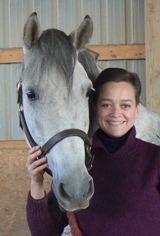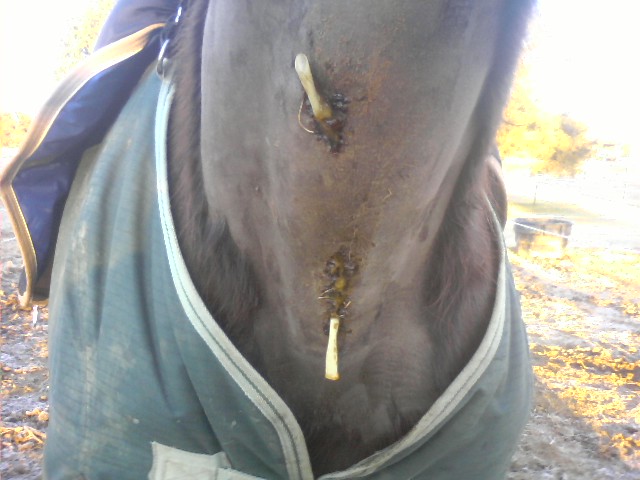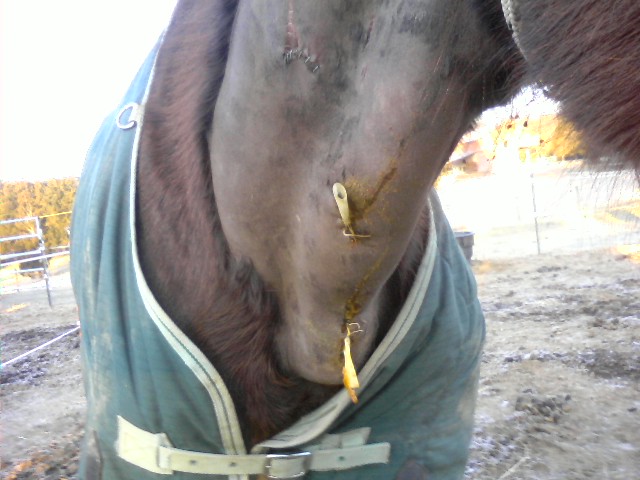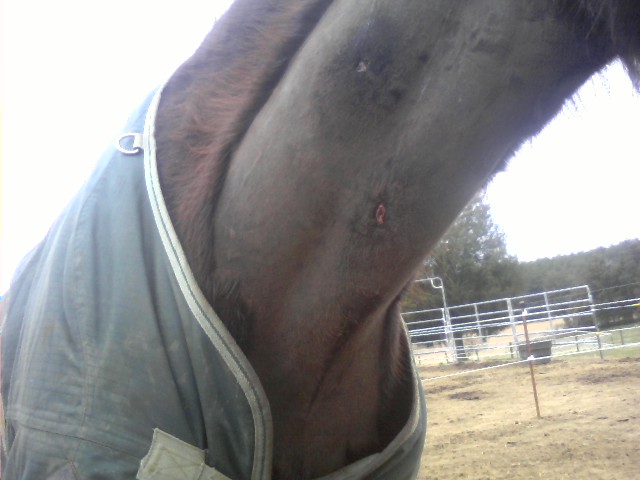.jpg)
.jpg)
When Bad Things Happen to Good Horses
(Setting Your Horse Up for Optimal Healing)
(published as "Laurel's Story" in the September/October 2009 issue of Equine Wellness magazine)
It’s every horse owner’s worst nightmare – a traumatic, potentially life-threatening injury. Our equine friends have such powerful spirits. They are a part of our lives and our souls, holding special places there like few others. Their strength and benevolence inspires us, and their trust in us is almost unfathomable. We do everything in our power to care for and provide for them. And then one day we go out to the barn and find a gaping wound. Or you find your beloved companion trapped somewhere. Or he comes in from the pasture dragging a limb – or doesn’t come at all when we call for him. The knot that forms in the pit of your stomach meets up wit dread when we begin to realize the gravity of the situation.
I had such a day just a few short months ago. It was a day like any other on my farm. I had finished my conference calls for the day and stopped at the barn to turn horses out for a few minutes on pasture while I ran into town to mail a parcel before the post office closed. The weather had been extraordinarily cold, and the ground was hard. The footing was firm for winter months, so I didn’t worry about any of the horses slipping or hurting themselves while they had a quick romp.
I watched as the four of them disappeared across the field together, feeling the breath catch in my throat as it always does when I see them just being horses together. I could feel their footfalls for a while through the soles of my own shoes – what great therapy at the end of a long day at the office dealing with lawyers and staring at my computer screen. They headed for the far end of that particular pasture, just like they did every day. There is a line of cedar trees that cuts right through the middle, dividing it in half. Several trees are missing, leaving huge gaps that the horses dash through to get to the far side of the field.
But that day was different. One of the horses, my lovely and elegant Laurel, took a shortcut through a gap in those trees that wasn’t really a gap. Laurel is a 17.1hh Clydesdale/Thoroughbred cross, and she’s the athlete in the family. Her long legs carry her over the ground so much faster than the other horses. In her exuberance to play with her buddies, she overtook them right at the tree line and tucked that huge body through a space too small for her. I heard the cracking of branches and cringed.
I stood at the fence watching as they all continued to race around the far end of the pasture together, kicking up their heels and squealing as if they were little foals turned out for the first time to stretch their legs. Laurel was with them – she didn’t miss a beat. I looked for anything out of the ordinary, a misstep, a slowing of their play. But everything appeared to be normal. Whew. I breathed a sigh of relief and realized that I’d been holding my breath.
After another few minutes, seeing nothing amiss with the horses from a distance, I looked at my watch and climbed back into my truck for the quick trip to town. Yet as I stopped at the end of the driveway before pulling out on to the country road, something tickled at the back of my mind – a little niggling at the back of my brain. I am thankful for the many people over the years who have encouraged me to listen to and trust my intuition. I said to myself, “Hmmmm, I’m going to go back and check…”
A few minutes later, and I was walking away from the truck that I’d now parked and shut off – heading out into the pasture where the horses were still playing and finally settling down to munch at the snippets of winter grass at their feet. As I got closer, dear Laurel came trotting up to me, and as she turned to the side and stopped her feet as I approached, I saw it. A branch from the cedar tree. She had impaled herself on it, and it had broken off from the trunk. There stood my beautiful friend, with about 10 inches of a substantial stick poking out of her neck. I couldn’t tell how much of it was buried in her. But from the angle of the protruding end, I could tell that the stick had followed the jugular groove – right down her throat.
I said a silent prayer of thanks that I have been given the gift of a very level head in a disaster. And I knew that Laurel would be looking to me for a reaction. She followed along beside me, with no halter or lead, as I headed back to her paddock, as if she knew that she needed the help I was about to offer. I’ve told so many people since then how fortunate I am that she is a good patient since she outweighs me by over 1200 pounds. She came to me over 7 years ago as a never-been-touched-by-human-hands weanling. And she is one of the most trusting and willing horses I’ve ever encountered.
I knew not to pull out the stick – puncture wounds are best handled by a professional who can be sure to find the end of the “pocket” that is formed at the end of the wound. And if she had nicked any vital structures, she could have bled out when I removed the stick. I placed a call to a veterinarian who had been referred to me six months prior when I’d moved to that farm. Dr. Vicki Newell agreed to come out to assess the situation and provide what assistance she could. And while I waited for her to arrive, I began to prepare to transport Laurel to a surgery about 45 minutes away – I suspected that this would be the likely course of action. I brought the other horses in from pasture and fed them their afternoon hay ration. I worked to stay calm and keep all of the horses calm – just business as usual as I set about the chores of the day and waited for Dr. Newell to arrive.
And all the time I was thinking about what I was sure would happen. Given the location of the injury, I knew that there was a distinct possibility that I was going to have to put this lovely creature down. My mind headed off into the logistics that action would require – it was probably a blessing in disguise as the thoughts allowed me to detach myself from the gravity of the situation.. Meanwhile, I monitored Laurel’s condition. And I worked acupressure points for colic and shock. I did cranio sacral therapy on her to keep her calm and make sure that her energy was moving despite the wound.
When Dr. Newell arrived, she agreed that I would need to haul the horse to Dr. Tom Dixon for surgery – there was nothing we could do for her there at my farm except ensure that she wouldn’t go into shock and cut some of the stick off to allow for easier transport and a decreased possibility of Laurel causing herself further injury. So we set about accomplishing that task. I live by myself out in the country, so having that extra set of hands that evening to cut some of the branch away was an extraordinary gift. Dr. Newell monitored Laurel’s vitals and was pleasantly surprised that she had no elevated pulse, no elevated respirations, great capillary refill – all good signs. Laurel began to tremble eventually – a sign of the adrenaline that had to be racing through her veins. But Dr. Newell determined that the horse did not require any sedatives before I loaded her into the trailer for the trek to the city for surgery.
Dr. Tom Dixon of Winston-Salem performed the surgery. He shared later that evening that when he’d seen her come off the trailer he was afraid he would have to put her down. But his quick and efficient action to surgically remove the stick and clean the two large puncture wounds was nothing short of extraordinary. The photos that I took with my cell phone while in the surgery clearly show the depth of the wounds. There was a second deep puncture wound above where the stick was protruding, but no branch had been left in that one – just a gaping hole. I left his clinic two hours later with Laurel in my trailer – unbelievable. It was a miracle that Laurel did NOT harm either her jugular or her trachea.
I had instructions to keep the wound clean and to flush a saline/iodine solution through the drain twice a day. Dr.’s Dixon and Newell had both warned me of the fluid pockets that would likely develop below the wound. They surmised that the fluid retention in the area would be significant and that the pocket would eventually drop between her front legs on her chest in an effort to drain. And we were sent home with antibiotics to prevent infection.
After I returned to the farm and settled Laurel in with her equine friends for what was left of the night, I formulated my plan for wound care using herbs, natural antiseptics, and energy work. My horses are maintained without chemicals, using all organic feeds, no chemical wormers, barefoot – as natural as I can make their environment. They are extraordinarily healthy. And that was the first and most important step in Laurel’s healing – she started with a healthy body.
The photos I took 12 hours after the surgery and every 24 hours after that exhibit the fabulous healing ability of this mare. The fluid pocket 12 hours after we left Dr. Dixon’s surgery was the size of a football, and the swelling was so extensive that you couldn’t see any shape to Laurel’s throat at all. I continued to apply an herbal spray topically and perform energy work on her entire body as well as the wound itself. At the 36 hour mark, the fluid had been reduced to the size of a grapefruit. And by 60 hours post-surgery, there was no fluid remaining.
I continued flushing the saline/iodine solution provided by the veterinarian through the drain and into the other puncture wound 2-3 times daily. And I also used a natural and very powerful antiseptic to facilitate healing and decrease the opportunity for infection. I closely monitored Laurel’s vitals and the wound for any signs of infection. Dr. Newell came back to the farm on day 8 to remove the drain and several staples. And I removed the stitches at day 11.
Once the wound began to close, I added a topical wound salve to assist in healing. And once it was closed fully, I used a wound balm and manual stimulation to decrease the scar tissue both at the surface and underneath. We just passed the four month mark, and you can see from the photographs how dramatic the healing has been. There is barely any scar at all. And there are absolutely no negative side-effects from Laurel’s adventure. I couldn’t have hoped for a better outcome.
The entire adventure began with a healthy and fit horse. She remained calm and composed throughout the treatments both the day of the injury as well as the weeks of after care. The herbs, energy work, acupressure, and topical treatments facilitated an unbelievable healing. And this beautiful and spirited creature was quickly back to racing around the pasture with her mates – and taking my breath away every time I see her. We are thankful for the vet’s who provided their talent and assistance. And I am eternally grateful for the people who have taught me the natural healing work that enabled me to ensure that Laurel continued to thrive today.

425-830-6260

%20020509.jpg)


%20020409.jpg)
%20020409.jpg)